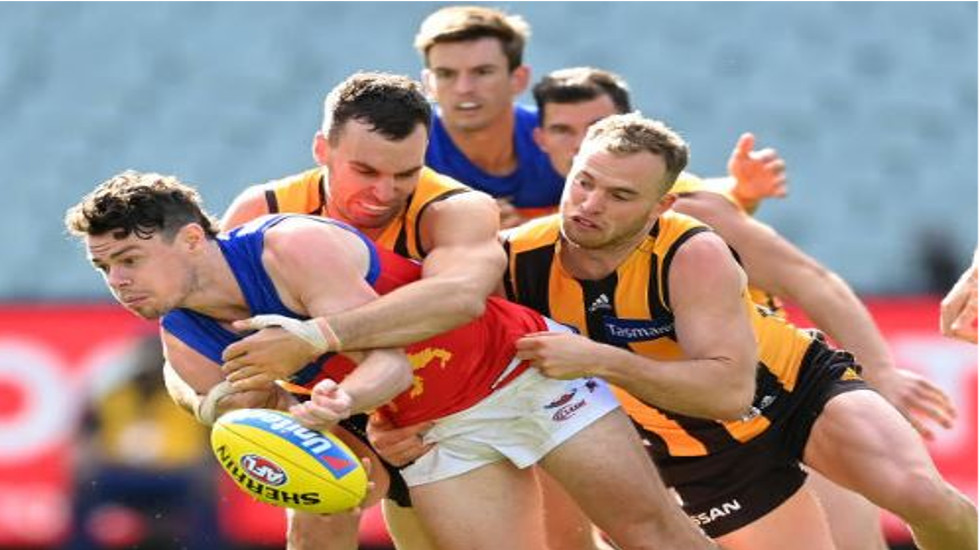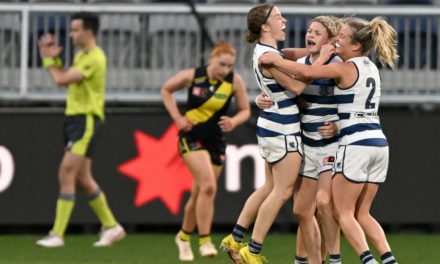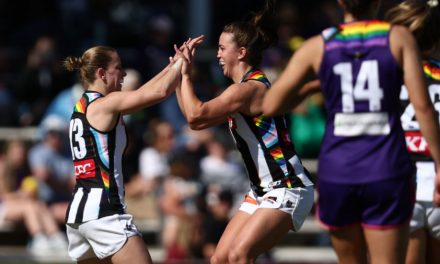Hawthorn and Brisbane hadn’t even reached half-time before the AFL pulled the pin on this season. Photo: GETTY IMAGES
If a week is a long time in football, what’s a couple of weeks during a global pandemic? It feels more like a lifetime.
Rewind to 8 March, and more than 86,000 fans packed the MCG for the Women’s T20 World Cup final.
By last Thursday night, the AFL season opener resembled a light thud rather than going off with its usual big bang.
Measures in place to stop the coronavirus spread dictated the only “crowd” of note at the home of football was a somewhat relaxed-looking Neil Balme casting an eye over his Tigers’ latest kill.
Only a win for lowly Carlton against the reigning premier could have made the season opener behind closed doors any more weird.
Yet Richmond might have spent the second quarter blowing the froth off a few jars across the road at the famous Royal Hotel and still come away with four points.
The open roof at Docklands allowed more players and staff to gather in an ‘outdoor’ setting than if it was closed.
It also let rain hit the turf on more than one occasion – a rarity since stadium management was panned for leaving the roof open during an A-League grand final more than a decade ago.
A tough, contested brand was the feature of Collingwood’s demolition of the Dogs in slippery conditions early on Friday night.
Coach Nathan Buckley suggested that would be the way football is won with quarters significantly reduced in length for the 2020 season.
We might find out at some stage. At least we hope we do.
Like the Magpies, West Coast flexed its considerable muscle in Perth with a comfortable win over Melbourne.
Richmond, of course, had done the same against the Blues, and Greater Western Sydney made a significant statement in its win over Geelong. Ditto Hawthorn as it beat Brisbane, last year’s big improver.
The Essendon-Fremantle, Adelaide-Sydney and North Melbourne-St Kilda contests provided tight finishes that gave fans some fleeting distraction from more important things in these uncertain times.
So, too, did umpiring controversy, as fans took to social media to lambast the apparent “rule of the week”, that appeared this time to be a crackdown on defenders impeding forwards’ attempts to mark.
Phil Davis was one of many backmen left dumbfounded when he was judged to have unfairly dealt with Tom Hawkins in a one-on-one contest. Hawkins hitting the post with his resulting free kick was some sort of justice.
An interesting side note for football reporters in sparsely populated press boxes around the country was that they were able to tune in to sounds of the game in real time.
With the glass windows open, players’ calls and instructions to each other were clearly audible for those lucky enough to be given the green light to work at the games played in the most unusual circumstances.
Those select few included former Fremantle and St Kilda coach Ross Lyon, who sat tucked away in a corner of the Marvel Stadium print media box for three quarters on Friday night as Collingwood ran riot.
Dan Hannebery was particularly vocal at the same cavernous venue on Sunday.
But soon after Hannebery’s Saints had fallen to North Melbourne, we were all left contemplating what the point of it all was, with the competition shut down until 31 May 31 the face of the coronavirus crisis.
AFLW was hit hard, too, as Gillon McLachlan announced the immediate cancellation of a women’s competition that was in the midst of its hastily-revamped finals campaign.
Facing an NBL-style decision on whether to award the premiership cup after the cancellation, the AFL decided it would be too “contrived” to pick a flag winner from the four remaining teams.
Fremantle arguably had the strongest case, having built a perfect 7-0 record across the season, including a record-breaking semi-final hammering of Gold Coast.
But the reasoning against its worthiness was equally as compelling.
Because of the uneven fixture – something that should be fixed when football and life return to normality – the Dockers were yet to play against any of their three fellow preliminary finalists this year.
North Melbourne was widely considered flag favourite, and both Carlton and Melbourne would rightly have considered themselves genuine chances to salute on grand final day if they got that far. Indeed, any of the four sides left in flag contention could have won it from where they were.
Perhaps that’s a pointer towards something we can all look forward to next year – a women’s competition that is going from strength to strength and has the capacity to throw up any sort of result.
Hopefully we can flatten the curve and see more of that sort of action in the men’s competition at some stage this year, too.











